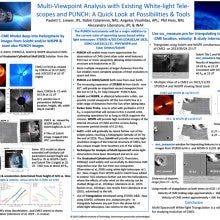Opportunities for Multi-Viewpoint Analysis with PUNCH and Existing White-light Telescopes: An Overview
Paulett C.
Liewer
Jet Propulsion Laboratory, California Institute of Technology
Robin Colaninno, Naval Research Laboratory, Washington, DC
Angelos Vourlidas, Johns Hopkins University Applied Physics Laboratory
Alessandro Liberatore, Jet Propulsion Laboratory, California Institute of Technology
Phil Hess, Naval Research Laboratory, Washington, DC
Angelos Vourlidas, Johns Hopkins University Applied Physics Laboratory
Alessandro Liberatore, Jet Propulsion Laboratory, California Institute of Technology
Phil Hess, Naval Research Laboratory, Washington, DC
Poster
The PUNCH instruments will be a major addition to the current suite of operating space-based white light telescopes aboard SOHO (LASCO\C2 & C3); STEREO-A (STA: SECCHI/COR1, COR2, HI-1, HI-2), Parker Solar Probe (PSP: WISPR) and Solar Orbiter (SolO: SoloHI). PUNCH’s field of view (FOV) from 6 Rsun to 45° from the Sun will enable many more opportunities for observations of CMEs (and other solar wind features) from two or more viewpoints, providing additional information to help determine their structure and trajectories in three dimensions. More images of CMEs from multiple viewpoints at larger distances from the Sun will enable more complete analyses of their spatial-temporal evolution. PUNCH and SOHO/LASCO, both fixed near Earth, share a common point of view. The separation of STA from Earth, now 30 o, will continue to increase, providing an important second viewpoint from the Sun to 15 Rsun.
SoloHI and WISPR, in their elliptical heliocentric orbits, can provide additional viewpoints for time periods when they are operational. When available, their elliptical orbits can provide images from crucial viewpoints off the Sun-Earth line at a wide range of distances from the Sun. The Graduated-Cylindrical-Shell (GCS; Thernisien, 2006ApJ) has been used widely and successfully to determine CME trajectories near the Sun from two viewpoints (Thernisien et al, 2009) using white-light telescopes at 1 AU. More recently, images from WISPR and/or SoloHI have been added to extend the GCS solutions further out into the heliosphere, where the effects of solar wind drag on the velocity can be studied (Braga et al., 2024ApJ; Liberatore et al., 2024ApJ; Romeo et al., 2023ApJ). After reaching its closest perihelion of 9.9 Rsun on 24 December 2024, it is expected that will remain in this 3-month period orbit in the plane of Venus, continuing operations for as long as NASA supports the mission and will provide high resolution images of the internal structure of CMEs and the corona during encounter periods (inside of 0.25 AU). SolO’s orbit will gradually be raised further out of the ecliptic plane, reaching a heliographic latitude of 24° by the end of 2026. Thus, SoloHI will provide not only high-resolution images of the internal structure of CMEs, but also unique images from locations out of the ecliptic.
SoloHI and WISPR, in their elliptical heliocentric orbits, can provide additional viewpoints for time periods when they are operational. When available, their elliptical orbits can provide images from crucial viewpoints off the Sun-Earth line at a wide range of distances from the Sun. The Graduated-Cylindrical-Shell (GCS; Thernisien, 2006ApJ) has been used widely and successfully to determine CME trajectories near the Sun from two viewpoints (Thernisien et al, 2009) using white-light telescopes at 1 AU. More recently, images from WISPR and/or SoloHI have been added to extend the GCS solutions further out into the heliosphere, where the effects of solar wind drag on the velocity can be studied (Braga et al., 2024ApJ; Liberatore et al., 2024ApJ; Romeo et al., 2023ApJ). After reaching its closest perihelion of 9.9 Rsun on 24 December 2024, it is expected that will remain in this 3-month period orbit in the plane of Venus, continuing operations for as long as NASA supports the mission and will provide high resolution images of the internal structure of CMEs and the corona during encounter periods (inside of 0.25 AU). SolO’s orbit will gradually be raised further out of the ecliptic plane, reaching a heliographic latitude of 24° by the end of 2026. Thus, SoloHI will provide not only high-resolution images of the internal structure of CMEs, but also unique images from locations out of the ecliptic.

Poster PDF
Meeting homepage